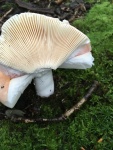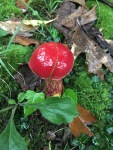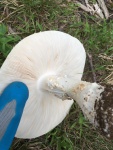This post is more about me learning and trying to remember things about mushrooms than it is to post how much I know. A Google search will tell you all the things that I’m about to tell you from much more reputable sources, but writing things down and reflecting on them is an important part of learning. So, I’ll try to demonstrate some of my own learning in the following paragraphs.
Mushrooms are eukaryotic (enclosed nucleus within cells) organisms that include yeasts, molds, and mushrooms. Mushrooms are not plants and they are not animals either, they are part of a separate kingdom all on their own. I’ll speak mainly about mushrooms in this post.
We are most familiar with mushrooms that we see in the supermarket or perhaps in video-games powering up Italian plumbers with ‘staches. However, the mushroom that we think of as the whole shebang is really just a small part of a much larger and extremely essential organism found almost everywhere in the world. Many people are afraid of mushrooms since they can be fatally toxic and are usually associated with death and decay, but as with most things, a bit of knowledge goes a huge way in removing that fear and making them just another wonderous part of life that we should stop and take a look at.
The mushrooms we see are really the fruiting bodies (they generate spores to propagate the fungus) created by the larger and hidden mycelium which are a complex network of filaments that usually thread themselves through whatever the fungus is feeding on. If you’ve ever upturned some damp fallen leaves on the ground during fall and seen a whiteish mesh threading through them, that’s the main body of a fungus!
Once the mycelium has reached a certain size and density it will create a mushroom. The specifics of mushroom creation are unknown to me, but it goes through a button or immature stage. Some mushrooms have a universal veil which covers the mushroom as it grows and can turn into a white dots called warts on the surface (look up fly agaric), or it can create a little cup from which the mushroom looks like it is growing from. More specific parts of a mushroom can be found with a search, but I can’t remember them off the top of my head!
One thing you’ll also notice is that many mushrooms have gills, if you’ve ever cooked any store-bought mushrooms before, you’ve seen them. Gills are where spores are generated to be carried on the wind to create more fungal colonies away from the current location of the fungus. However, gills are not the only spore creating structures, some mushrooms have pores, some have ridges, and some even have little-inverted points like teeth!
Enough with the blah blah, I’ll show some pictures I’ve gotten of mushrooms on a hike I went recently. I have no idea what the mushrooms are but I’m working on learning how to identify them using various methods. Note that it is safe to touch a mushroom (though it might be slimy), and you can’t get poisoned through your skin. Just be sure to wash your hands if you handle a mushroom that you are unfamiliar with.
I’ll post again when I’m able to make some amateur identifications!
If I’ve piqued your curiosity, feel free to go to these websites to learn more! Also, if you’re located in NJ, USA there’s a Mycological Association of NJ that hosts forays regularly so be sure to look at those too!
NJ Mycological Association
Mushroom Expert
Mushroom World
Just as a warning, DO NOT TRUST PICTURES ON THE INTERNET TO IDENTIFY MUSHROOMS TO BE EATEN. This is for educational purposes only. Plus it’s super hard to correctly identify certain edible mushrooms from inedible or even toxic specimens. Mushroom identification is a skill that should be built with the help of professional mycologist and endless hours of personal experience. Unless you enjoy mycotoxins beating the living daylights out of your liver or kidneys or are an experienced forager, don’t eat any mushroom you pick out of the woods.







